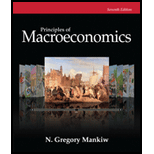
Lags in the effect of monetary and fiscal policies.
Explanation of Solution
Concept introduction:
Monetary policy: Monetary policy refers to the credit
Fiscal Policy: Fiscal policy deals with the
Want to see more full solutions like this?
Chapter 23 Solutions
Principles of Macroeconomics (MindTap Course List)
- What causes the lags in the effect of monetary and fiscal policies on aggregatedemand? What are the implications of these lags for the debate over active versuspassive policy?arrow_forwardDefine the following: -Inside lag -Outside lag Which has the longer lag-monetary or fiscal policy? Which has the longer outside lag? Give reasons for your answer?arrow_forwardWhat effect will a successful supply-side policy have on the aggregate demand curve? A) Leftward shift B) Rightward shift C) Movement down along D) Movement up alongarrow_forward
- Predict how possible changes in monetary and/or fiscal policy may impact the supply and demand of the iPhone.arrow_forwardAs you have learned in Unit 8 (this week), monetary and fiscal policy play important roles in economic stimulation and or stabilization. In this regard:What specific fiscal policy tools would you use to stimulate aggregate demand and how?What specific monetary policy tools would you use to stimulate aggregate demand and how?What is your conclusion, should policymakers use the monetary and or fiscal policy, or a combination of both, to stimulate aggregate demand? Explain your reasoning.arrow_forwardSuppose that government spending is increased at the same time when an autonomous monetary policy tightening occurs. What will happen to the position of the aggregate demand curve?arrow_forward
- Explain what types of policies the federal government may have implemented to restore aggregate demand and the potential obstacles policymakers may have encountered.arrow_forwardWhat type of policy are this using (expansionary or contractionary)? How will it impact unemployment, GDP, inflation? How will it impact aggregate supply and demand? Will these changes harm our economy? Are they worth it?arrow_forwardSuppose that survey measures of consumer confidence indicates a wave of pressimism is sweeping the country. If policy maker do nothing, what will happen to aggregate demand? What should the fed do of it wants to stabilize the aggregate demand? If fed does nothing then what congress should do to stabilize the aggregate demand?arrow_forward
- Why is the shape of the aggregate supply curve important to the Keynesian-monetarist controversy? (Hint: Review Exhibit 6 of Chapter 26 in the chapter on aggregate demand and supply.arrow_forwardWhich of the following does not cause the aggregate demand curve to shift to the right? A) A tightening monetary policy. B) An investment boom C) An expansionary fiscal policy D) An expansionary monetary policyarrow_forwardAs you have learned in Unit 8 (this week), monetary and fiscal policy play important roles in economic stimulation and or stabilization. In this regard: a. When is it appropriate to use monetary and fiscal policy to stimulate or stabilize the economy? b. When is it inappropriate to use monetary and fiscal policy to stimulate or stabilize the economy? c. What specific fiscal policy tools would you use to stimulate aggregate demand and how? d. What specific monetary policy tools would you use to stimulate aggregate demand and how? e. What is your conclusion, should policymakers use the monetary and or fiscal policy to stimulate aggregate demand? Explain briefly.arrow_forward
 Brief Principles of Macroeconomics (MindTap Cours...EconomicsISBN:9781337091985Author:N. Gregory MankiwPublisher:Cengage Learning
Brief Principles of Macroeconomics (MindTap Cours...EconomicsISBN:9781337091985Author:N. Gregory MankiwPublisher:Cengage Learning
 Economics (MindTap Course List)EconomicsISBN:9781337617383Author:Roger A. ArnoldPublisher:Cengage Learning
Economics (MindTap Course List)EconomicsISBN:9781337617383Author:Roger A. ArnoldPublisher:Cengage Learning







